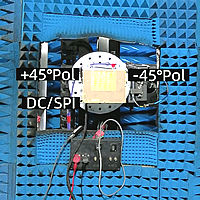
A 24.25–27.5 GHz 128-element dual-polarized 5G integrated phased array with 5.6%-EVM 400-MHz 64-QAM and 50-dBm EIRP
Liu H Q, Zhao D X, Yi Y R, et al
Sci China Inf Sci, 2022, 65(11): 214301
With the rapid evolution of mobile communication technology, the data volume of new mobile services is growing exponentially, resulting in an explosive demand for increased data throughput. The 5G millimeter-wave (mm-Wave) frequency bands offer massive spectrum resources, which can greatly improve the communication rate and provide numerous possibilities for ultra-high-speed communication services. Compared to the traditional GaAs- or GaN-based implementation, the mm-Wave phased array based on the silicon complementary metal oxide semiconductor (CMOS) technology enables large-scale network coverage for mm-Wave 5G base stations at a low cost. The mm-Wave 5G uses 24.25–27.5 GHz as the operation band, covering the 3GPP 5G NR FR2 N258 band. Owing to the trade-off between the size of the mm-Wave array and the number of beamformer ICs, ensuring a low thermal density chip distribution along with an optimal performance of the phasedarray antenna can be challenging. An enhanced communication data rate can be achieved by using a dual-polarized antenna, which offers the advantage of reducing the number of the two independent antenna units. However, it is difficult to implement an integrated dual-polarized antenna for an overall small physical size. To compensate for the influence of the increased path loss at the mm-Wave, the linear output power of the phased-array antenna must be guaranteed. Furthermore, the cross-polarization performance and the large angle scan degradation of the dual-polarized antenna are also challenging.